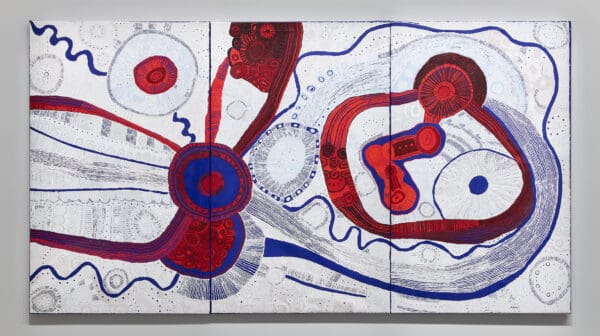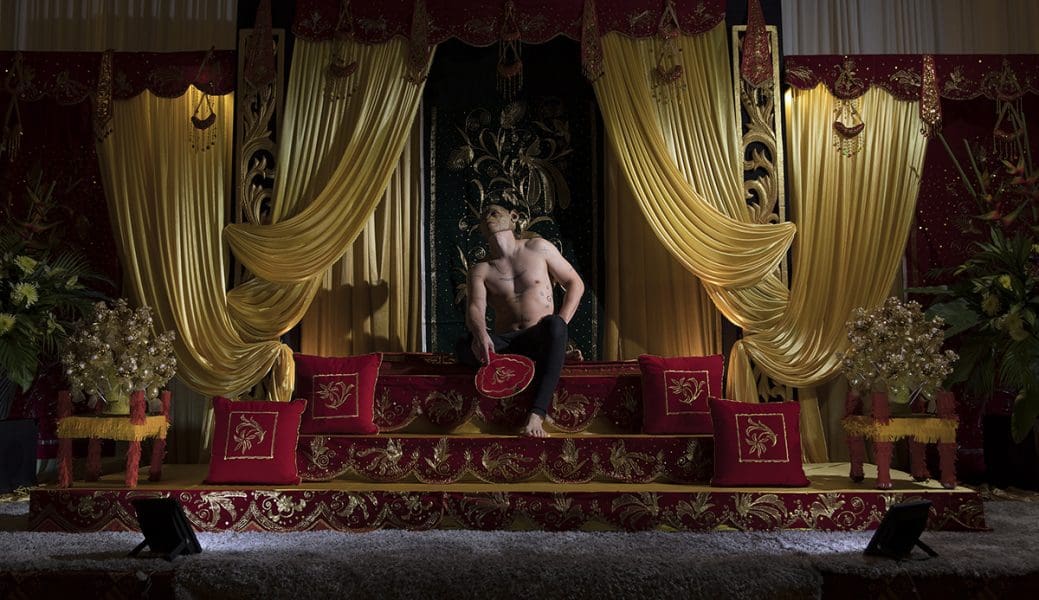
Life Cycles with Betty Kuntiwa Pumani
The paintings of Betty Kuntiwa Pumani form a part of a larger, living archive on Antaṟa, her mother’s Country. More than maps, they speak to ancestral songlines, place and ceremony.

Abdul Abdullah, Journey to the West (2017), digital print, 75cm x 130cm. Courtesy the artist and Lisa Fehily Contemporary Art, Melbourne.

Abdullah M.I. Syed, Weaving Myth VI – U.S. vs China (Flying Rug Series) (detail) (2013), hand-cut and woven 100 US Dollar bill and 100 Chinese Yuan. Courtesy the artist and Aicon Gallery, New York.
As a part of Adelaide Festival, ACE Open will exhibit Waqt al-tagheer, a show which ponders temporality while amplifying the voices of Eleven, a new collective of Muslim Australian artists. Eleven began in 2016 as a way to build community through collaboration and mentorship.
The theme of time unfolds at two speeds; contemporary turbulence and eons of history. These paths cross with At the speed of light by Khaled Sabsabi, where a ring of screens shows the night sky – an arena for angelic light and scientific observation. Curator Abdul-Rahman Abdullah hopes viewers will sense terrestrial and celestial “worlds converging, as a whole night appears in zero-point-something of a second.”

Convergence is a preoccupation for Abdullah and co-curator Nur Shkembi: works that exist in dual states lead the exhibition. Shireen Taweel’s Musallah is a circlet of patterned copper, a commemoration of Australia’s earliest (now-demolished) mosque in Whyalla, South Australia. Monumental yet quiet, the work contemplates the mosque’s fleeting material lifespan, compressing “150 years of history into one, still moment.”
Abdullah’s masterfully carved sculpture, 500 Books, depicts a stack of Sufi texts his father once saved from pulping. “Books are infinitely scalable, yet these were nearly lost,” he says. “Five hundred is a lot, but it’s also tiny. Massive best-sellers reach only the tiniest blip of humanity.”
Three photographs by Abdul Abdullah depict a lavishly ornamented Malaysian wedding. The couple wear balaclavas. They’re subject to projections of criminality and otherness: flimsy stereotypes contrived by blinkered aggressors. “I reflect on how Muslims are perceived,” says the artist. “I ask my audience to afford others the complexity they afford themselves.”
Such work is often cast in terms of politics and media vitriol: as response, not expression. Wat al-tagheer consciously provides “a platform for self-definition,” explains Abdullah. “The artists worked as they saw fit, with or without taking into account any broader political context.”
Waqt al-tagheer: Time of change
ACE Open
3 March – 21 April